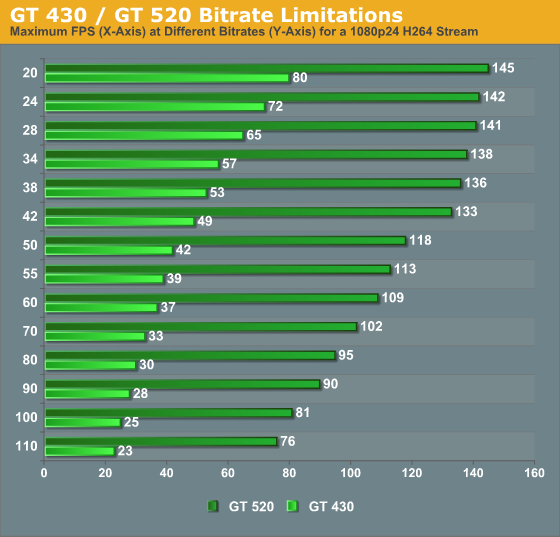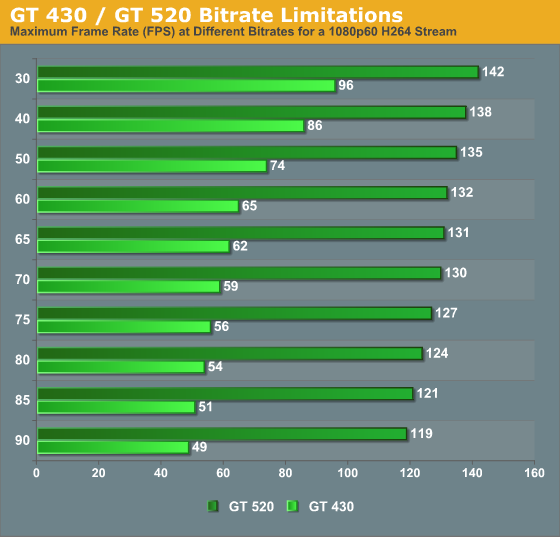Discrete HTPC GPU Shootout
by Ganesh T S on June 12, 2011 10:30 PM ESTIn the previous section, I mentioned about the bitrate limitations of the GT 430 when decoding 1080p H264 clips. NVIDIA confirmed that the GT 430 couldn't decode 60 fps videos at 80 Mbps. This piqued my curiosity and I tried out a few experiments to find out whether bitrate limitations exist for the usual 1080p24 videos on both the GT 430 and GT 520.
The DXVA Checker benchmark was repeated for all the bitrate testing files found in the NMT test files upto 110 Mbps.

We also created our own suite of bitrate testing streams at 1080p60. Running them through the DXVA Checker benchmark yielded the following results.

The results are presented in a bar chart above (A line chart would have made much more sense, but the outer values get placed only for bar charts in our graphing engine). For 1080p24 streams, we find that the GT 430 is unable to keep up with the real time decode frame rate requirements at 110 Mbps. For 1080p60 streams, the limit gets further reduced to somewhere between 65 and 70 Mbps. The GT 520 has no such issues.
The above testing is only of academic interest, since there is no real 1080p24 content at 110 Mbps. Even 3D Blu-rays max out around 60 Mbps (and that includes the audio stream!), so users shouldn't really be concerned about this bitrate limitation of the GT 430.
The GT 520's scores above are more interesting. Even the high end GPUs such as the 460 and 560 are unable to achieve that frame rate. The answer was buried in the README for the latest Linux drivers. The GT 520 is the first (and only GPU as of now) to support the VDPAU Feature Set D.
We asked NVIDIA about the changes in the new VDPAU feature set and what it meant for Windows users. They indicated that the new VPU was a faster version, also capable of decoding 4K x 2K videos. This means that the existing dual stream acceleration for 1080p videos has now been bumped up to quad stream acceleration.
Though the GPU can decode 4K videos, it is unfortunately not able to output it through HDMI. Despite the HDMI controller being advertised as HDMI 1.4a, it doesn't implement the 4K x 2K resolution part of the standard. The lack of HDMI sinks which accept that resolution is another matter, but that should get resolved in the next few years.
Despite the GT 520's advanced VPU engine, the lack of shaders limits its post processing capabilities. With all post processing options enabled, the GT 520's GPU load was always between 60 and 80%. The memory controller load (DRAM bandwidth usage) was between 20 and 40%. Despite the headroom apparently available, NVIDIA indicated that there weren't enough shaders available to implement the more advanced deinterlacing algorithms.










70 Comments
View All Comments
jwilliams4200 - Monday, June 13, 2011 - link
All the numbers add up correctly now. Thanks for monitoring the comments and fixing the errors!Samus - Monday, June 13, 2011 - link
Honestly, my Geforce 210 has been chillin' in my HTPC for 2+ years, and works perfectly :)josephclemente - Monday, June 13, 2011 - link
If I am running a Sandy Bridge system with Intel HD Graphics 3000, do these cards have any benefit over integrated graphics? What is Anandtech's HQV Benchmark score?I tried searching for scores, but people say this is subjective and one reviewer may differ from another. One site says 196 and another in the low 100's. What does this reviewer say?
ganeshts - Monday, June 13, 2011 - link
Give me a couple of weeks. I will be getting a test system soon with the HD 3000, and I will do detailed HQV benchmarking in that review too.dmsher99@gmail.com - Tuesday, June 14, 2011 - link
I recently built a HTPC with a core i5-2500k on a ASUS P8H67 EVO with a Ceton InfiniTV cable card. Note that the Intel driver is fundamentally flawed and will destroy a system if patched. See the Intel communities thread 20439 for more details.Besides causing BSOD over HDMI output when patched, the stable versions have their own sets of bugs including a memory bleed when watching some premium content on HD channels that crashed WMC. Intel appears to have 1 part time developer working on this problem but every test river he puts out breaks more than it fixes. Watching the same, content with a system running a NVIDIA GPU and the memory bleed goes away.
In my opinion, second gen SB chips is just not ready for prime time in a fully loaded HTPC.
jwilliams4200 - Monday, June 13, 2011 - link
"The first shot shows the appearance of the video without denoising turned on. The second shot shows the performance with denoising turned off. "Heads I win, tails you lose!
ganeshts - Monday, June 13, 2011 - link
Again, sorry for the slip-up, and thanks for bringing it to our notice. Fixed it. Hopefully, the gallery pictures cleared up the confusion (particularly the Noise Reduction entry in the NVIDIA Control Panel)stmok - Monday, June 13, 2011 - link
Looking through various driver release README files, it appears the mobile Nvidia Quadro NVS 4200M (PCI Device ID: 0x1056) also has this feature set.The first stable Linux driver (x86) to introduce support for Feature Set D is 270.41.03 release.
=> ftp://download.nvidia.com/XFree86/Linux-x86/270.41...
It shows only the Geforce GT 520 and Quadro NVS 4200M support Feature Set D.
The most recent one confirms that they are still the only models to support it.
=> ftp://download.nvidia.com/XFree86/Linux-x86/275.09...
ganeshts - Monday, June 13, 2011 - link
Thanks for bringing it to our notice. When that page was being written (around 2 weeks back), the README indicated that the GT 520 was the only GPU supporting Feature Set D. We will let the article stand as-is, and I am sure readers perusing the comments will become aware of this new GPU.havoti97 - Monday, June 13, 2011 - link
So basically the app store's purpose is to attract submissions of ideas for features of their next OS, uncompensated of course. All the other crap/fart apps not worthy are approved and people make pennies of those.